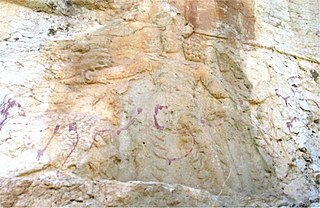Nimrud is an ancient city in modern Iraq.
Contents
Nimrud may also refer to:
Nimrud is an ancient city in modern Iraq.
Nimrud may also refer to:
Yam or YAM may refer to:

Nimrud is an ancient Assyrian city located in Iraq, 30 kilometres (20 mi) south of the city of Mosul, and 5 kilometres (3 mi) south of the village of Selamiyah, in the Nineveh Plains in Upper Mesopotamia. It was a major Assyrian city between approximately 1350 BC and 610 BC. The city is located in a strategic position 10 kilometres (6 mi) north of the point that the river Tigris meets its tributary the Great Zab. The city covered an area of 360 hectares. The ruins of the city were found within one kilometre (1,100 yd) of the modern-day Assyrian village of Noomanea in Nineveh Governorate, Iraq.

Ashur-nasir-pal II was the third king of the Neo-Assyrian Empire from 883 to 859 BCE. Ashurnasirpal II succeeded his father, Tukulti-Ninurta II. His son and successor was Shalmaneser III and his queen was Mullissu-mukannišat-Ninua.
Bahman is the 11th month of the year in Zoroastrian & Iranian calendars, named after the Zoroastrian concept.
Bahar may refer to:
Mehran is derived from the term mehr, relating to Mithra, an ancient Zoroastrian Persian deity.
Nizamabad, Nezamabad, or Nazmabad, may refer to:
Bostan, Bustan, Boustan or Boostan may refer to:
Namrud is a village in Shahrabad Rural District, in the Central District of Firuzkuh County, Tehran Province, Iran. At the 2006 census, its population was 28, made up of 10 families.
Saidabad is a city in Hyderabad, India.
Salehabad or Salihabad or Salhabad or Salahabad may refer to:
Sharifabad may refer to:
Sinak or Senak may refer to:
Nimrud is a village in Bezenjan Rural District, in the Central District of Baft County, Kerman Province, Iran. At the 2006 census, its population was 35, in 10 families.
Kahrizak is a city in Rey County, Tehran Province, Iran.
Fath may refer to:

The Nimrud Slab, also known as the Calah Orthostat Slab, is the top half of a "summary inscription" of the reign of Adad-nirari III discovered in 1854 by William Loftus in his excavations at Nimrud on behalf of the Assyrian Excavation Fund.
The Nimrud Tablet K.3751, also known as Kalhu Palace Summary Inscription 7 is an inscription on a clay tablet dated c. 733 BC from the reign of Tiglath-Pileser III, discovered by George Smith in 1873 in Nimrud. The tablet describes the first 17 years of Tiglath-Pileser III's reign and was likely composed in or shortly after his 17th year. It contains the first known archeological reference to Judah.

Sar Mashhad is a village in Dadin Rural District of Jereh and Baladeh District, Kazerun County, Fars province, Iran.

Assyrian sculpture is the sculpture of the ancient Assyrian states, especially the Neo-Assyrian Empire of 911 to 612 BC, which was centered around the city of Assur in Mesopotamia which at its height, ruled over all of Mesopotamia, the Levant and Egypt, as well as portions of Anatolia, Arabia and modern-day Iran and Armenia. It forms a phase of the art of Mesopotamia, differing in particular because of its much greater use of stone and gypsum alabaster for large sculpture.